
Home
Privacy, Terms & Conditions
Occasional Papers
Ancient Mysteries
BOOKSHOP
Epsom and Ewell Waters
Archives/Reviews
Awards Gallery
Destiny
Malvern Waters and Malverns Worldwide
Somerville Diaries
Grotto News
Grotto Essays
Grotto.DirectoryGROTTO INFORMATION AND ESSAYS 
In 1768 Arthur Young published his diary of his tour of Southern England. The scope of his tour can be ascertained by the detailed route maps which can be accessed by clicking below.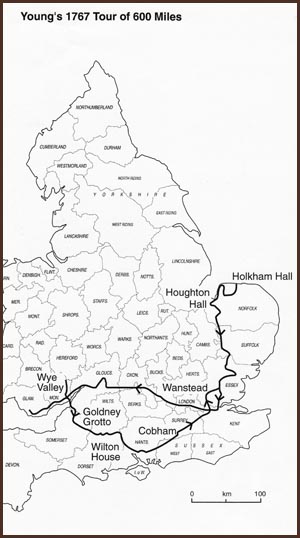
On the route maps, places highlighted in magenta are mentioned in Young's text. In particular he visited and recorded a number of landmark sites. These are identified in the larger magenta text. To enlarge or reduce the size of the route maps on screen use ctrl+ or - .
One of the features that appeared in many of the landmark sites that Arthur Young visited was the grotto. The first Italianate grotto in England was at Henry VIII's Nonsuch Palace in the 16th century. The tradition of the mystic grotto as a 'heavenly cave' garden feature was established by the ancient Greeks and Romans.
In Britain, grottoes became a fashionable feature to have on the estates of the wealthy from the 17th century onwards. This Renaissance inspiration came from Italy and during the 17th and 18th centuries the landed gentry competed to create the most imaginative and impressive. These cave like structures had several necessary requirements. Grottoes were a place of mystery and awe where the visitor could indulge in mythological fantasies. Essentials included a sacred spring and portrayals of gods and creatures that inspired the imagination. In the grotto construction, the creative use of natural materials such as tufa, semi precious stones and sea shells went alongside statues and re-used architectural features. When coupled with fireworks, music and mystery enactments this all created a place where the imagination could run riot. 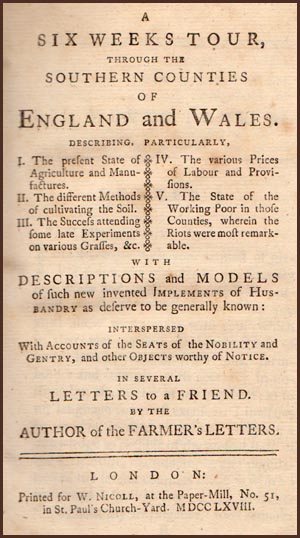
Arthur Young recorded his discoveries and observations in his writings, as did many other early tourists such as Celia Fiennes. Many children of the aristocracy went on the Grand Tour through European cities in early adulthood. Here they saw grandiose grottoes and some shipped back souvenirs in the form of statuary to recreate the grotto on their own estates. Others employed advisors to guide them in grotto design in their country parks.
Young's comments on the subsequent creations provide a valuable guide as to the occurrence and quality of grottoes in his time. In recognition of his endeavours we have initiated the Grotto Grading scheme. This provides a quick and easy quality guide to grottoes that exist in the 21st century. For details of the scheme go to our home page by clicking GB Grotto Grading on the menu left.
The following landmark sites are commented on at length in Young's text. The page numbering guidance is based on the first edition. Further detail on what he saw, particularly the grottoes, can be seen by clicking on the names in the index, accessible from the home page at Grotto.directory (click bottom of this page).
Blenheim Grotto pages 92-99
Persfield pages 130-145
Goldney Grotto pages 147-149
Wilton House pages 158-167
Painshill or Cobham Park pages 187-192
Wanstead House pages 196-200
The full text of Arthur Young's publication A six weeks tour through the southern counties of England and Wales (1768), Young, Arthur, 1741-1820 can be accessed on-line by clicking on the horseman right.
FURTHER READING
Miller, Naomi. 1982, Heavenly Caves, George Allen and Unwin Ltd.
Jackson, Hazel. 2001, Shell Houses and Grottoes, Shire Pubs.
Beamon, Sylvia P. 2002, Underground Mythology, Able Publishing.
Mythology was and still is a belief system that enables mankind to make some sense of the world around us before science discovers a rational explanation. It is therefore an interim step in the evolving of knowledge about understanding creation, ending with scientific enlightenment.
The grotto is a manifestation and celebration of this mythology, by creating a place of fantasy where the imagination overrules the rational explanation. The following on-line extract "The Grotto" by Dr Bruce E Osborne was first published in 2002 in Beaumon's Underground Mythology above, as one part of a more extensive paper "Exploring Water in Underground Mythology". This in turn was one of a number of papers included by other authors on underground beliefs and superstitions, including a detailed evaluation of Margate Grotto, dowsing, cave motifs, etc.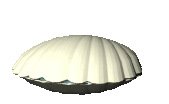
Saint James's Grotto Day July 25
In England during the late 18th and early 19th centuries, shellfish, particularly oysters, were not considered the rare delicacy they are today and were, in fact, one of the common staples of fishermen's diets. The large number of shellfish eaten at that time meant an amply supply of oyster and scallop shells. On St. James's Day, which was observed on August 5 before the Gregorian, or New Style, Calendar came into use and on July 25 thereafter, children used the shells to construct small decorative grottoes. These street grottoes were then used for begging pocket money from passers by. This was a custom that was prevalent in London but died out in the 1950s with Mitcham being one of the last places where it was practised.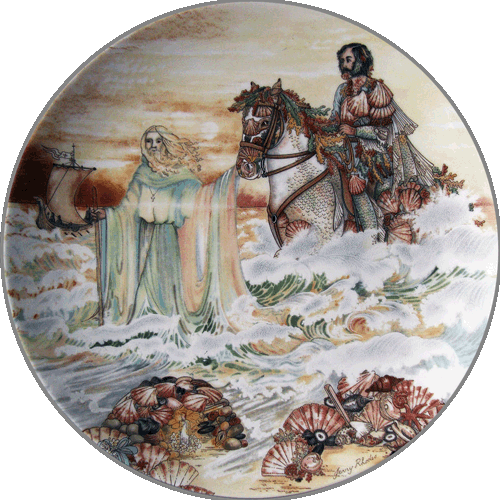
St. James the Great was one of the Apostles and brother to St. John the Evangelist. The scallop shell was his emblem. James, along with his brother John and father Zebedee, were fishermen on the Sea of Galilee. Tradition has it that his bones came to rest in Santiago de Compostela in northwestern Spain following his martyrdom. During the medieval period the shrine of St James became an important centre of pilgrimage, a practice which continues today. The scallop shell grooves all converge at one point as do the pilgrims. After his death in Jerusalem, Saint James's body was brought by boat to Spain. To welcome his return a man rode a horse into the sea. He would have drowned had the dead Saint not have rescued him by a miracle. As they emerged from the sea the horse and rider were covered in scallop shells. These shells became the emblem of Saint James, patron of all pilgrims.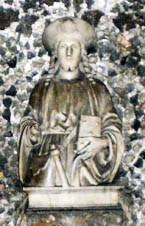
Alexander Pope was a 17th century famed author who created a mythological grotto in Twickenham on the banks of the River Thames. His grotto included a statue of St James which survives to this day. For more details go to Pope's Grotto information by clicking on the picture of St James.
Another instance where St James appears is in the nursery rhyme:
Mary, Mary, quite contrary,
How does your garden grow?
With silver bells, and cockle shells,
And pretty maids all in a row
Like many nursery rhymes, it has acquired various historical interpretations. One of these is that it is a religious allegory of Catholicism, with bells representing the sanctus bells, the cockleshells the badges of the pilgrims to the shrine of Saint James in Spain (Santiago de Compostela) and pretty maids are nuns. What is uncertain is whether it is lament for the reinstatement of Catholicism or for its persecution.
Like London afore mentioned, in Kent it is recorded that children made shell grottos out of oyster shells which thanks to the oyster trade were very common. Originally this would have been done by adults and was associated with anyone unable or unwilling to make the journey to St Jamesís shrine at Compostella. They used to visit a shell grotto or make one. By the 1800s this had been stripped largely of its catholic connotations and was a form of begging for children. By the 1960s the custom had died out. More recently however there has been a revival of the custom of children building grottoes using oyster shells. This has taken place in Whitstable and Margate beaches to celebrate St James's Day.
Illustrations:
1. Wedgewood grotto plate celebrating St James.
2. St James in Pope's Grotto.
For further details on Street Grottoes click below.

The Grotto Directory can be accessed by clicking the logo alongside this text.